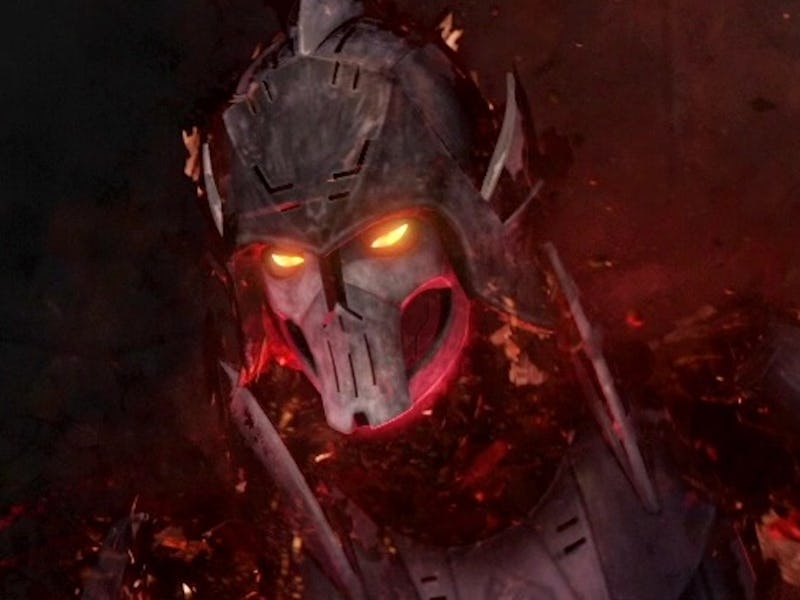The Acolyte Draws Inspiration From A Pivotal Non-Canon Sith
One of the most infamous villains influenced the exciting new series.

There are some rules in the world of Star Wars that you just don’t mess with: everything is affected by the Force, do or do not, there is no try, and when playing holochess, let the Wookiee win. But one of the most important Star Wars rules is also the most mysterious: the Rule of Two. But the next Disney+ Star Wars series, the first one to focus on the Sith, is finally going to explore this bit of lore and possibly fully incorporate two fascinating characters into canon.
The Acolyte showrunner Leslye Headland has always teased elements from the non-canon Legends timeline would be featured in the series, but fans have been kept in the dark about specifics. However, in a recent interview with Den of Geek, we finally got some more information as to how Legends would influence the series, in particular the fan-favorite non-canon villain Darth Bane.
“I really toyed with utilizing Darth Bane or mentioning Bane, We do not do it in the first season, but it is obviously the legacy of these practitioners of the dark side,” she said.
So what does Darth Bane mean for The Acolyte and the future of Star Wars canon? Let’s take a closer look at the history of this influential Sith Lord.
The rule of two begins...
In the Legends lore, Darth Bane is the ultimate Sith rebel who starred in his own trilogy of novels. Trained in the Sith Brotherhood, he overthrew the entire organization more than a millennium before the events of the Star Wars movies. He then created a new Sith philosophy: the Rule of Two, dictating there can only be two Sith at one time: a master to embody power and an apprentice to crave it — and the apprentice’s betrayal is inevitable. It’s why Anakin ultimately murders Palpatine (well, at least temporarily,) why Palpatine betrayed master Darth Plagueis, and why Darth Plagueis betrayed his master Darth Tenebrous. Ultimately, Bane was a victim of his own doctrine as he was murdered by his apprentice, Zannah.
Darth Bane’s place in the current canon is murky. While he does technically exist in mainstream Star Wars, it’s mostly through ambiguous sources like a statue mentioned in The Odyssey of Star Wars: An Epic Poem, a work of Homeric poetry that claims Palpatine had a statue of Bane in his throne room. In the actual visual media, Bane was set to appear in the famed Mortis arc of Star Was: The Clone Wars, but was only featured in deleted scenes.
Ten years ago, in season 6 of The Clone Wars, in the episode “Sacrifice,” Darth Bane appeared as a Force vision to Yoda. At the time Yoda was being tested by the Force Priestesses and was visiting the original Sith homeworld of Moraband. So before this episode, the only way you could know about Darth Bane, and his strange role in Sith history, would have been to have read the various novels. Hamill’s take on Darth Bane is strange to be sure, but, to date, marks the only in-canon appearance of the character.
Yoda faces the spirit of Darth Bane in The Clone Wars.
But, Bane wasn’t the only quasi-canon Sith character that influenced The Acolyte. In the same interview, Headland went on to mention a deadly Sith Lord who has never appeared on in a Star Wars TV series or movie: Darth Traya from the video game Knights of the Old Republic II.
“Darth Traya really stuck out to me as an inspiration,” she said.
It’s easy to see why. Darth Traya was a Jedi who wanted to find a better way of life but ultimately fell to the temptation of the Dark Side, much like The Acolyte’s main character Mae was initially a Jedi padawan but then became a Sith Acolyte.
With this knowledge, it seems like The Acolyte will give fans exactly what they want: more lore about the Sith, fleshing out the counterpart to the Jedi, and giving us an exclusive look into how that side of the Force works. Just because these characters may not be mentioned by name, their impact on the Star Wars universe is still very evident — even if it’s not canon, yet.